Nächste Seite: Re: Das neue Auswendig Aufwärts: Graphen, Schaltwerke und Zahlen Vorherige Seite: Re: Das neue Auswendig
<?php
session_start ();
?>
<form method="POST" action="./form20240415.php">
<input type="text" name="form20240415a"></input>
<input type="submit">
</form>
<?php
echo "Wir lassen weiterhin nichts b\&ouml;ses in unser Herz <br>n";
echo session_id () . "<br>n";
setcookie ("form20240415b", "Dies ist Cookie", time () + 2400);
echo htmlentities (\$_POST ["form20240415a"]) . "<br>n";
echo htmlentities (\$_COOKIE ["form20240415b"]) . "<br>n";
echo htmlentities (\$_COOKIE ["form20240415c"]) . "<br>n";
session_destroy ();
?>
POST http://localhost/mysql20240217/20240415/form20240415.php HTTP/1.1 host: localhost Cookie: form20240415c=Hallo, ich bin Keks Alternative Content-Length: 34 Content-Type: application/x-www-form-urlencoded form20240415a=Und ich bin das Date
Trying ::1... Connected to localhost. Escape character is '\^]'. HTTP/1.1 200 OK Date: Mon, 15 Apr 2024 10:11:25 GMT Server: Apache/2.4.57 (Debian) Set-Cookie: PHPSESSID=fvgf1n68bl74d4s7t4cn7elvta; path=/ Expires: Thu, 19 Nov 1981 08:52:00 GMT Cache-Control: no-store, no-cache, must-revalidate Pragma: no-cache Set-Cookie: form20240415b=Dies%20ist%20Cookie; expires=Mon, 15 Apr 2024 10:51:25 GMT; Max-Age=2400 Vary: Accept-Encoding Content-Length: 285 Content-Type: text/html; charset=UTF-8 <form method="POST" action="./form20240415.php"> <input type="text" name="form20240415a"></input> <input type="submit"> </form> Wir lassen weiterhin nichts b\&ouml;ses in unser Herz <br> fvgf1n68bl74d4s7t4cn7elvta<br> Und ich bin das Date<br> <br> Hallo, ich bin Keks Alternative<br>
<?php
session_start ();
include ("/home/david/mysqldata.php");
\$db = new PDO ("mysql: host=localhost", \$MYSQL_USER, \$MYSQL_PASSWORD);
\$sql = "CREATE DATABASE mysql20240415" . session_id () . "; ";
\$db->query (\$sql);
\$sql = "USE mysql20240415" . session_id () . "; ";
\$db->query (\$sql);
\$sql = "CREATE TABLE a (x1 INTEGER, x2 INTEGER); CREATE TABLE b (y1 INTEGER, y2 INTEGER); ";
\$db->query (\$sql);
\$sql = "INSERT INTO a (x2, x1) VALUES (0, 0); INSERT INTO a (x2, x1) VALUES (1, 0); INSERT INTO a (x2, x1) VALUES (0, 1); INSERT INTO a (x2, x1) VALUES (1, 1); INSERT INTO a (x2, x1) VALUES (7, 2); INSERT INTO b (y1, y2) VALUES (0, 1); INSERT INTO b (y1, y2) VALUES (1, 0); INSERT INTO b (y1, y2) VALUES (2, 7); ";
\$db->query (\$sql);
\$sql = "SELECT x1, x2 FROM a; ";
\$stmt = \$db->query (\$sql);
while (\$row = \$stmt -> fetch ())
echo \$row [0] . ", " . \$row [1] . "; ";
echo "<br>n";
\$sql = "SELECT y1, y2 FROM b; ";
\$stmt = \$db->query (\$sql);
while (\$row = \$stmt -> fetch ())
echo \$row [0] . ", " . \$row [1] . "; ";
echo "<br>n";
\$sql = "SELECT x1, x2, y1, y2 FROM a INNER JOIN b ON a.x1 = b.y1; ";
\$stmt = \$db->query (\$sql);
while (\$row = \$stmt -> fetch ())
echo \$row [0] . ", " . \$row [1] . ", " . \$row [2] . ", " . \$row [3] . "; ";
echo "<br>n";
\$sql = "DROP DATABASE mysql20240415" . session_id () . "; ";
\$db->query (\$sql);
session_destroy ();
?>
0, 0; 0, 1; 1, 0; 1, 1; 2, 7; <br> 0, 1; 1, 0; 2, 7; <br> 0, 0, 0, 1; 0, 1, 0, 1; 1, 0, 1, 0; 1, 1, 1, 0; 2, 7, 2, 7; <br>
<?php
session_start ();
include ("/home/david/mysqldata.php");
\$db = new PDO ("mysql: host=localhost", \$MYSQL_USER, \$MYSQL_PASSWORD);
\$sql = "CREATE DATABASE quantity20240415" . session_id () . "; ";
\$db->query (\$sql);
\$sql = "USE quantity20240415" . session_id () . "; ";
\$db->query (\$sql);
\$sql = "CREATE TABLE a (x INTEGER); CREATE TABLE b (x INTEGER); CREATE TABLE c (x INTEGER); ";
\$db->query (\$sql);
for (\$i = 0; \$i < 24; \$i++) {
\$sql = "INSERT INTO a (x) VALUES (" . rand () % 32 . "); ";
\$sql .= "INSERT INTO b (x) VALUES (" . rand () % 64 . "); ";
\$sql .= "INSERT INTO c (x) VALUES (" . rand () % 128 . "); ";
\$db->query (\$sql);
}
\$sql = "SELECT x FROM (SELECT x FROM a UNION SELECT x FROM b) x; ";
\$stmt = \$db->query (\$sql);
while (\$row = \$stmt -> fetch ())
echo \$row [0] . ", ";
echo ";<br>n";
\$sql = "SELECT x FROM (SELECT x FROM a UNION SELECT x FROM c) x; ";
\$stmt = \$db->query (\$sql);
while (\$row = \$stmt -> fetch ())
echo \$row [0] . ", ";
echo ";<br>n";
\$sql = "SELECT x FROM (SELECT x FROM b UNION SELECT x FROM c) x; ";
\$stmt = \$db->query (\$sql);
while (\$row = \$stmt -> fetch ())
echo \$row [0] . ", ";
echo ";<br>n";
\$sql = "SELECT x FROM (SELECT x FROM a INTERSECT SELECT x FROM b) x; ";
\$stmt = \$db->query (\$sql);
while (\$row = \$stmt -> fetch ())
echo \$row [0] . ", ";
echo ";<br>n";
\$sql = "SELECT x FROM (SELECT x FROM a INTERSECT SELECT x FROM c) x; ";
\$stmt = \$db->query (\$sql);
while (\$row = \$stmt -> fetch ())
echo \$row [0] . ", ";
echo ";<br>n";
\$sql = "SELECT x FROM (SELECT x FROM b INTERSECT SELECT x FROM c) x; ";
\$stmt = \$db->query (\$sql);
while (\$row = \$stmt -> fetch ())
echo \$row [0] . ", ";
echo ";<br>n";
\$sql = "SELECT x FROM (
SELECT x FROM (SELECT x FROM a UNION SELECT x FROM b) x
INTERSECT
SELECT x FROM c
) x ORDER BY x; ";
\$stmt = \$db->query (\$sql);
while (\$row = \$stmt -> fetch ())
echo \$row [0] . ", ";
echo ";<br>n";
\$sql = "SELECT x FROM (
SELECT x FROM (SELECT x FROM a INTERSECT SELECT x FROM c) x
UNION
SELECT x FROM (SELECT x FROM c INTERSECT SELECT x FROM b) x
) x ORDER BY x; ";
\$stmt = \$db->query (\$sql);
while (\$row = \$stmt -> fetch ())
echo \$row [0] . ", ";
echo ";<br>n";
\$sql = "SELECT x FROM (
SELECT x FROM (SELECT x FROM a UNION SELECT x FROM c) x
INTERSECT
SELECT x FROM b
) x ORDER BY x; ";
\$stmt = \$db->query (\$sql);
while (\$row = \$stmt -> fetch ())
echo \$row [0] . ", ";
echo ";<br>n";
\$sql = "SELECT x FROM (
SELECT x FROM (SELECT x FROM a INTERSECT SELECT x FROM b) x
UNION
SELECT x FROM (SELECT x FROM b INTERSECT SELECT x FROM c) x
) x ORDER BY x; ";
\$stmt = \$db->query (\$sql);
while (\$row = \$stmt -> fetch ())
echo \$row [0] . ", ";
echo ";<br>n";
\$sql = "SELECT x FROM (
SELECT x FROM (SELECT x FROM b UNION SELECT x FROM c) x
INTERSECT
SELECT x FROM a
) x ORDER BY x; ";
\$stmt = \$db->query (\$sql);
while (\$row = \$stmt -> fetch ())
echo \$row [0] . ", ";
echo ";<br>n";
\$sql = "SELECT x FROM (
SELECT x FROM (SELECT x FROM c INTERSECT SELECT x FROM a) x
UNION
SELECT x FROM (SELECT x FROM a INTERSECT SELECT x FROM b) x
) x ORDER BY x; ";
\$stmt = \$db->query (\$sql);
while (\$row = \$stmt -> fetch ())
echo \$row [0] . ", ";
echo ";<br>n";
\$sql = "DROP DATABASE quantity20240415" . session_id () . "; ";
\$db->query (\$sql);
session_destroy ();
?>
23, 8, 25, 4, 10, 29, 18, 11, 13, 22, 20, 5, 31, 21, 6, 0, 30, 12, 14, 46, 38, 51, 1, 43, 15, 59, 17, 42, 36, 52, 61, 32, 39, 49, 45, ;<br> 23, 8, 25, 4, 10, 29, 18, 11, 13, 22, 20, 5, 31, 21, 6, 0, 30, 12, 14, 108, 93, 74, 84, 125, 26, 38, 73, 103, 32, 105, 67, 55, 95, 39, 92, 63, 72, 28, 64, ;<br> 12, 25, 46, 38, 51, 1, 43, 15, 59, 17, 42, 31, 36, 29, 52, 61, 32, 39, 49, 45, 13, 108, 93, 74, 84, 125, 26, 73, 103, 105, 18, 67, 55, 95, 0, 92, 63, 72, 4, 28, 64, ;<br> 25, 29, 13, 31, 12, ;<br> 4, 29, 18, 0, ;<br> 38, 29, 32, 39, ;<br> 0, 4, 18, 29, 32, 38, 39, ;<br> 0, 4, 18, 29, 32, 38, 39, ;<br> 12, 13, 25, 29, 31, 32, 38, 39, ;<br> 12, 13, 25, 29, 31, 32, 38, 39, ;<br> 0, 4, 12, 13, 18, 25, 29, 31, ;<br> 0, 4, 12, 13, 18, 25, 29, 31, ;<br>
Ich mache heute noch Aufgaben, ich werde heute etwas länger wach bleiben, ich mache dafür länger Aufgaben - ich werde auch noch auswendig lernen und für Mathematik lernen Das werde ich auch tun. Und ich werde damit beginnen, die Schaltung mit dem Zilog Z80 zu bauen. Ich werde sie einfach zusammen stecken
Jetzt, die Aufgaben, wo ich heute stehen geblieben bin.
Spazieren gehen ist normal
wie gesagt, ich lasse nichts negatives rein
1.) Rechne die Zahl in binaer Darstellung in eine Dezimale Darstellung um
1011011110111111b 47039d
2.) Rechne die Zahl in dezimal darstellung in eine Binaerdarstellung um
1163 0000010010001011
3.) Addiere die drei Zahlen schriftlich
12007
+ 749
+ 58628
-----------------
71384
4.) Subtrahiere die letzten drei Zahlen schriftlich von der ersten schriftlich
12116
- 8025
- 5853
- 5289
-----------------
-7051
5.) Rechne die Zahl ins zweier komplement um, mit 8 Bit - und subtrahiere diese zahl von der ersten und rechne das Ergebnis nach dezimal
85 -35 = 50
01010101 11011101 = 00110010
6.) Multipliziere die zwei Zahlen schriftlich
10547*2896 = 30544112
7.) Dividiere die zwei Zahlen schriftlich
33909/43570 = 0
8.) Errechne x Logarithmisch mit dem Taschenrechner
31210\^x = 659784529
Rechne die Zahl in IEEE-754 um 16718.492188
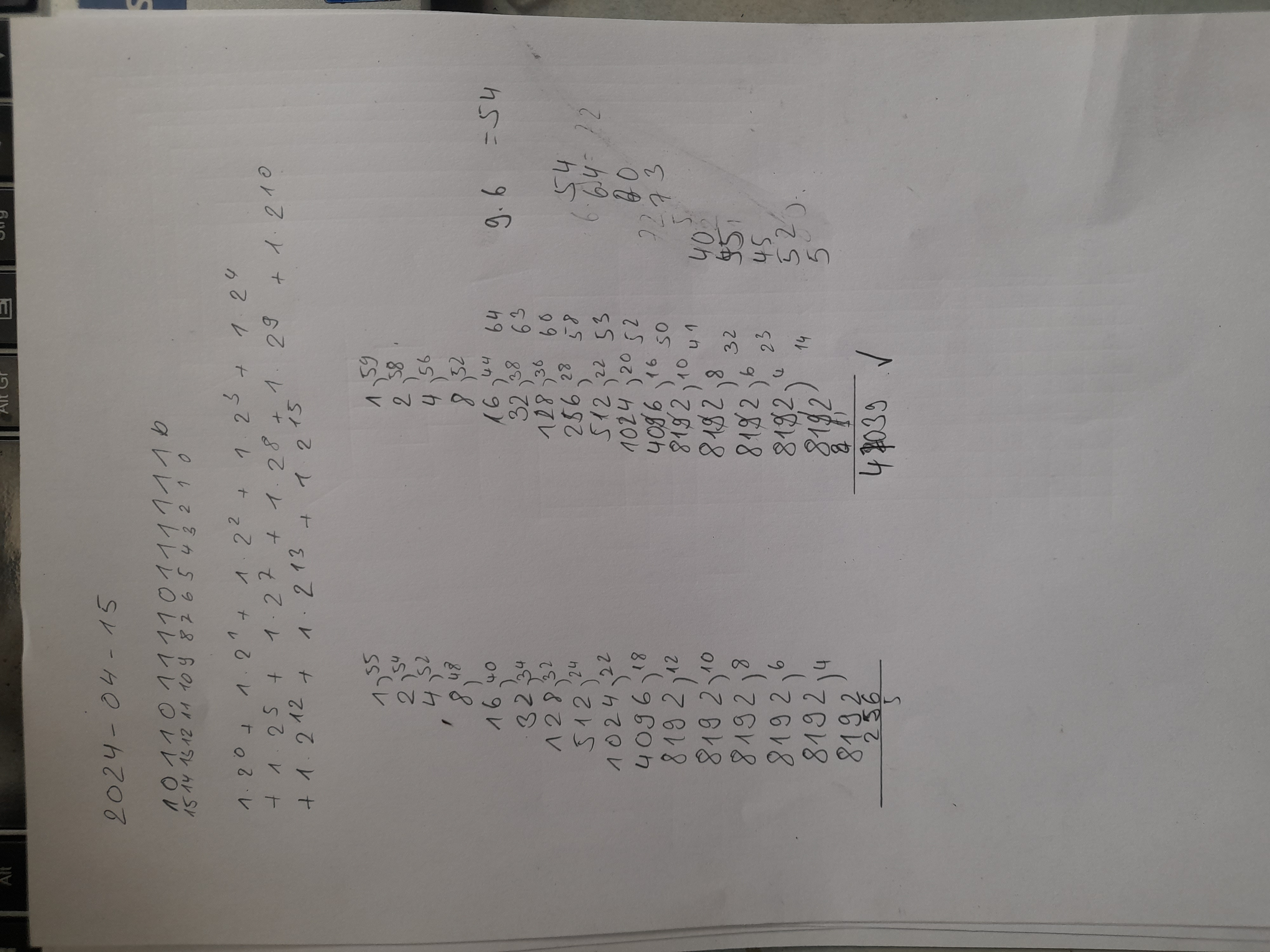
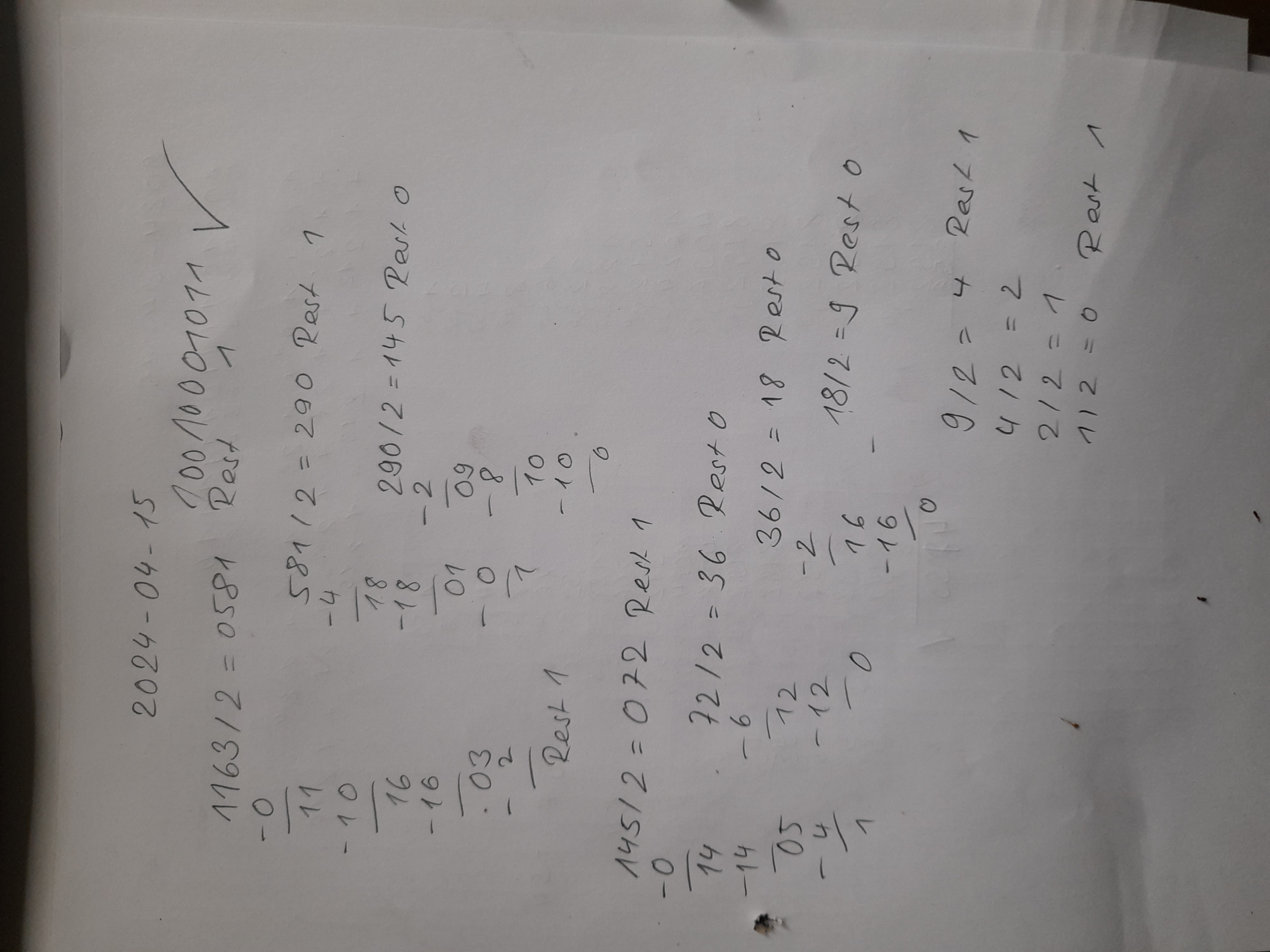
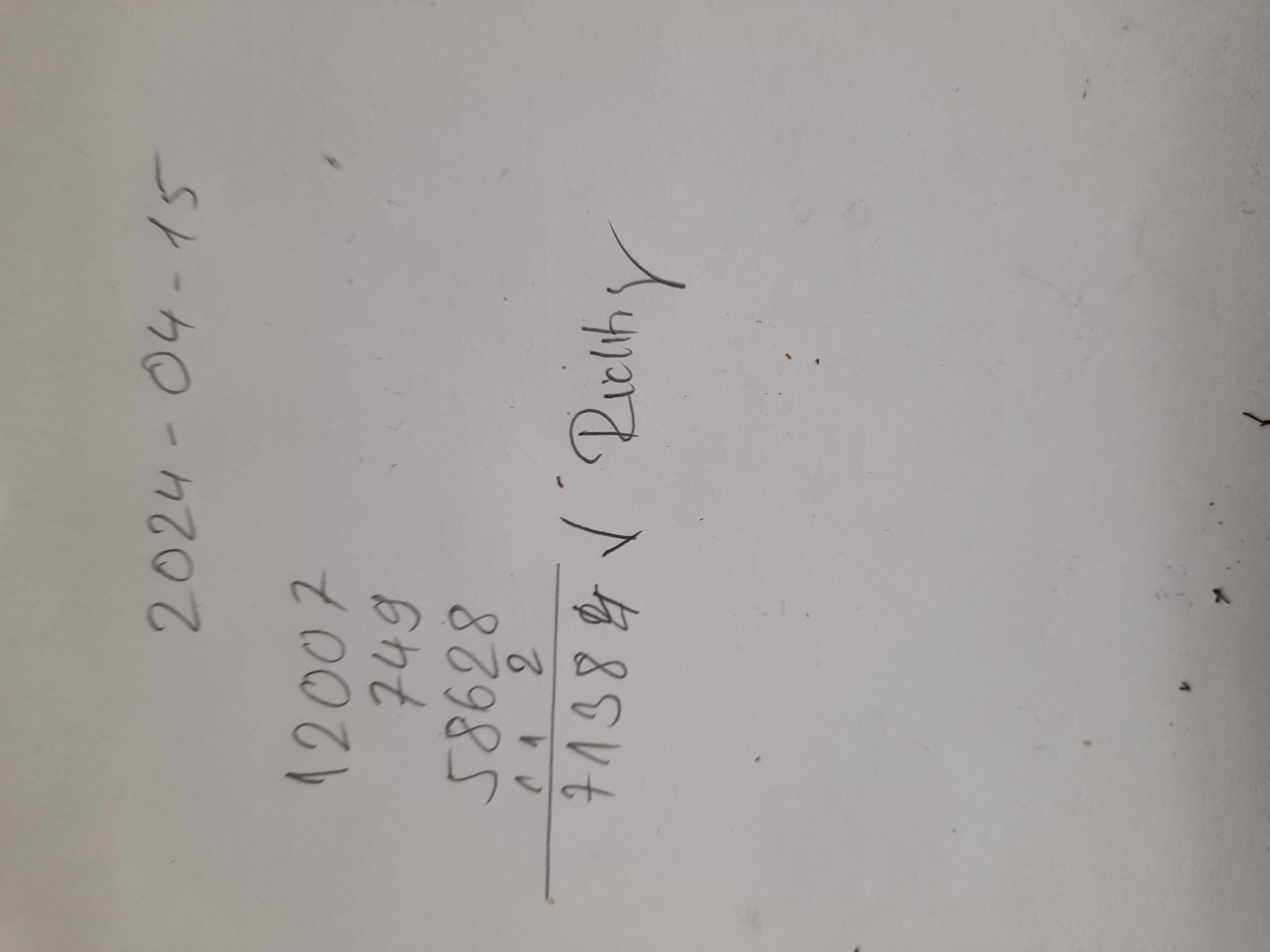
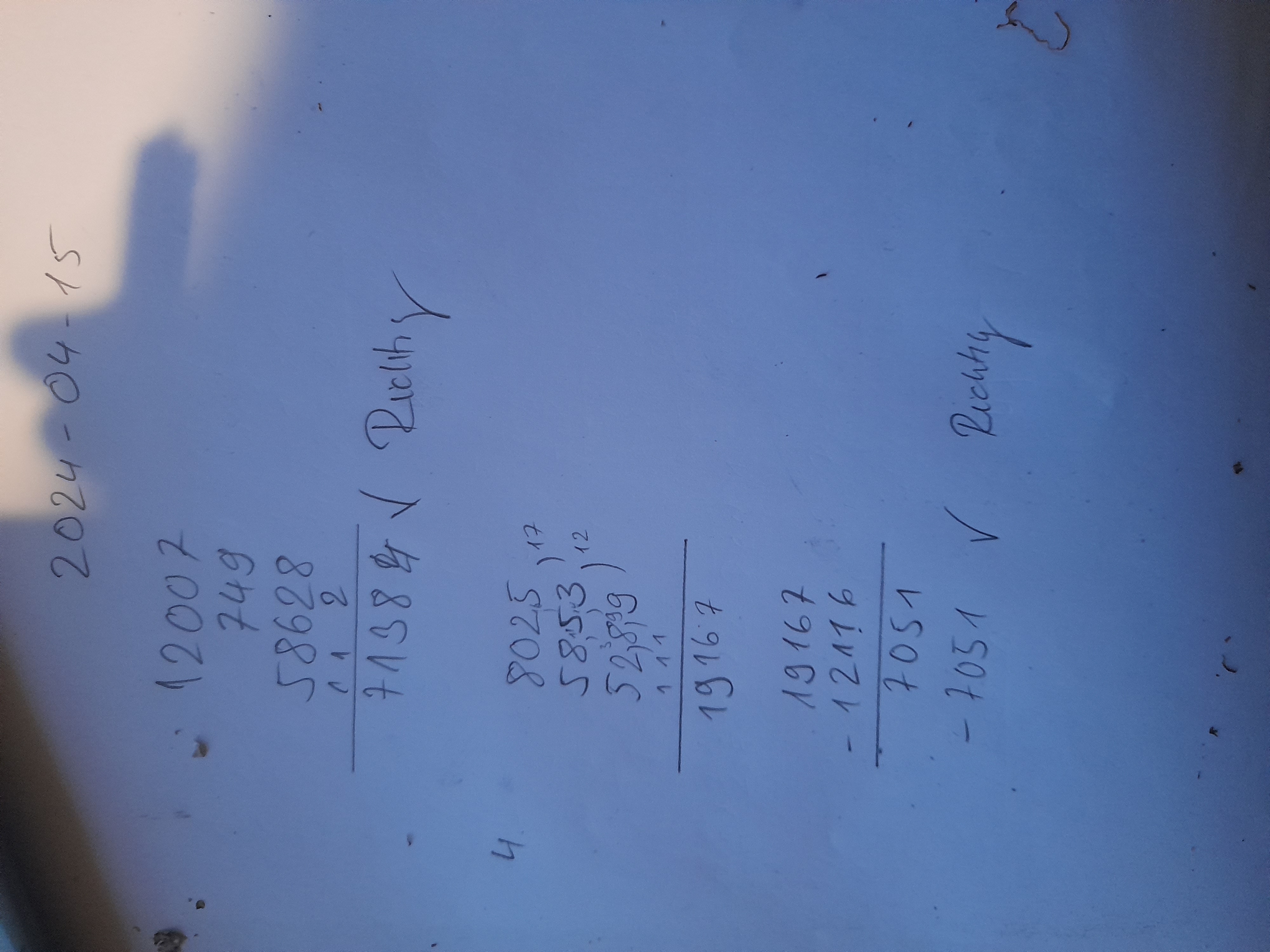
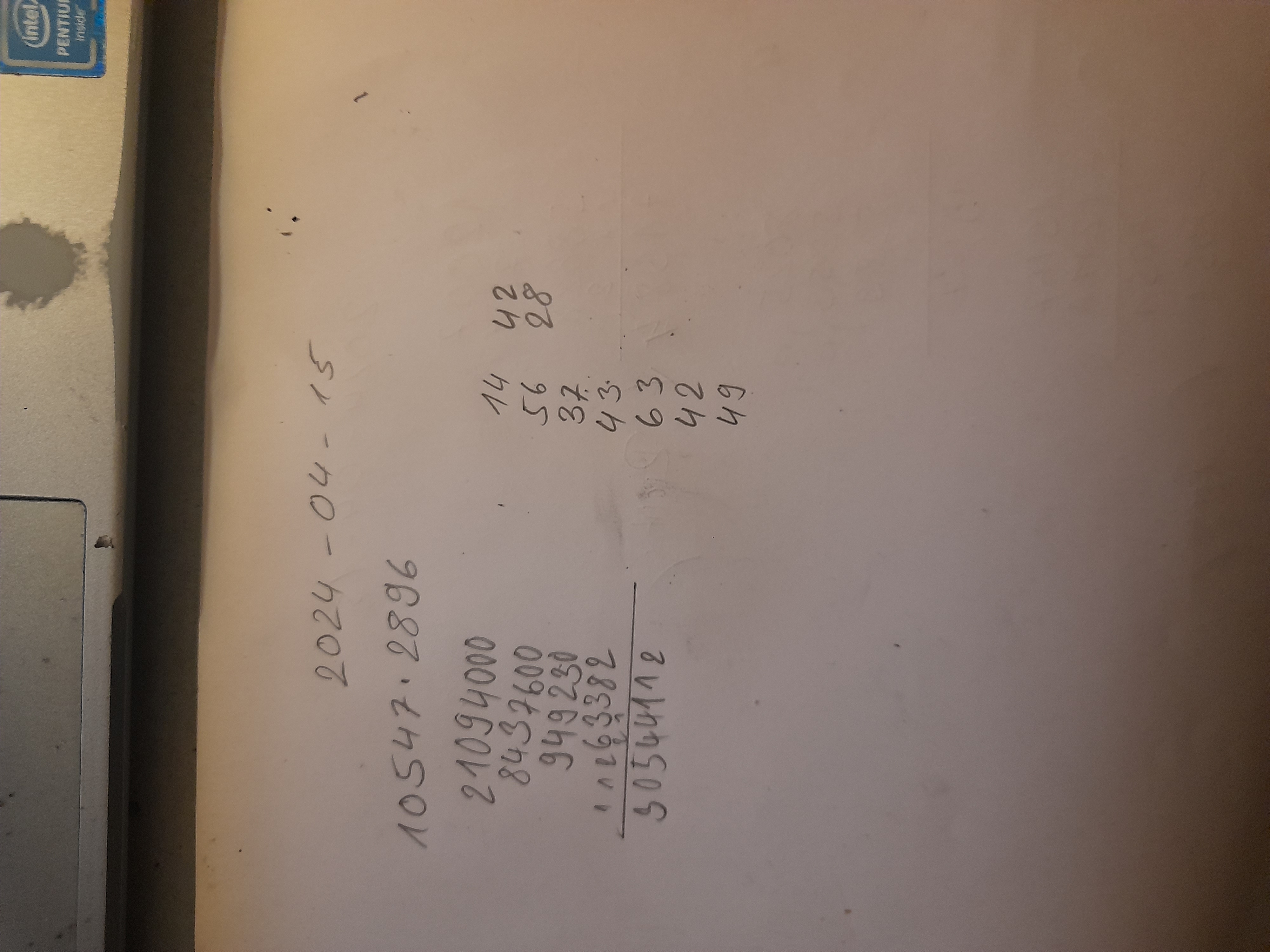
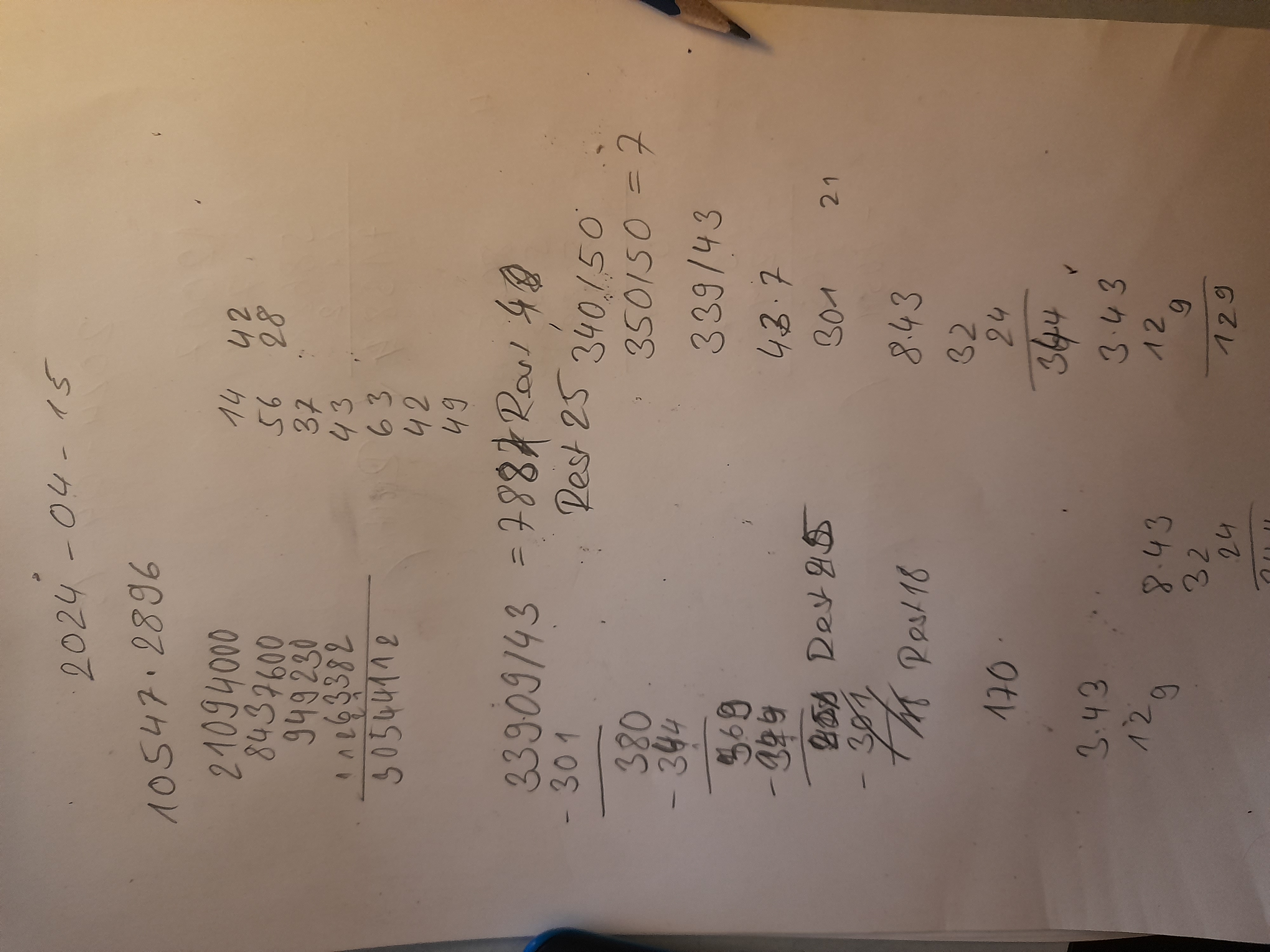
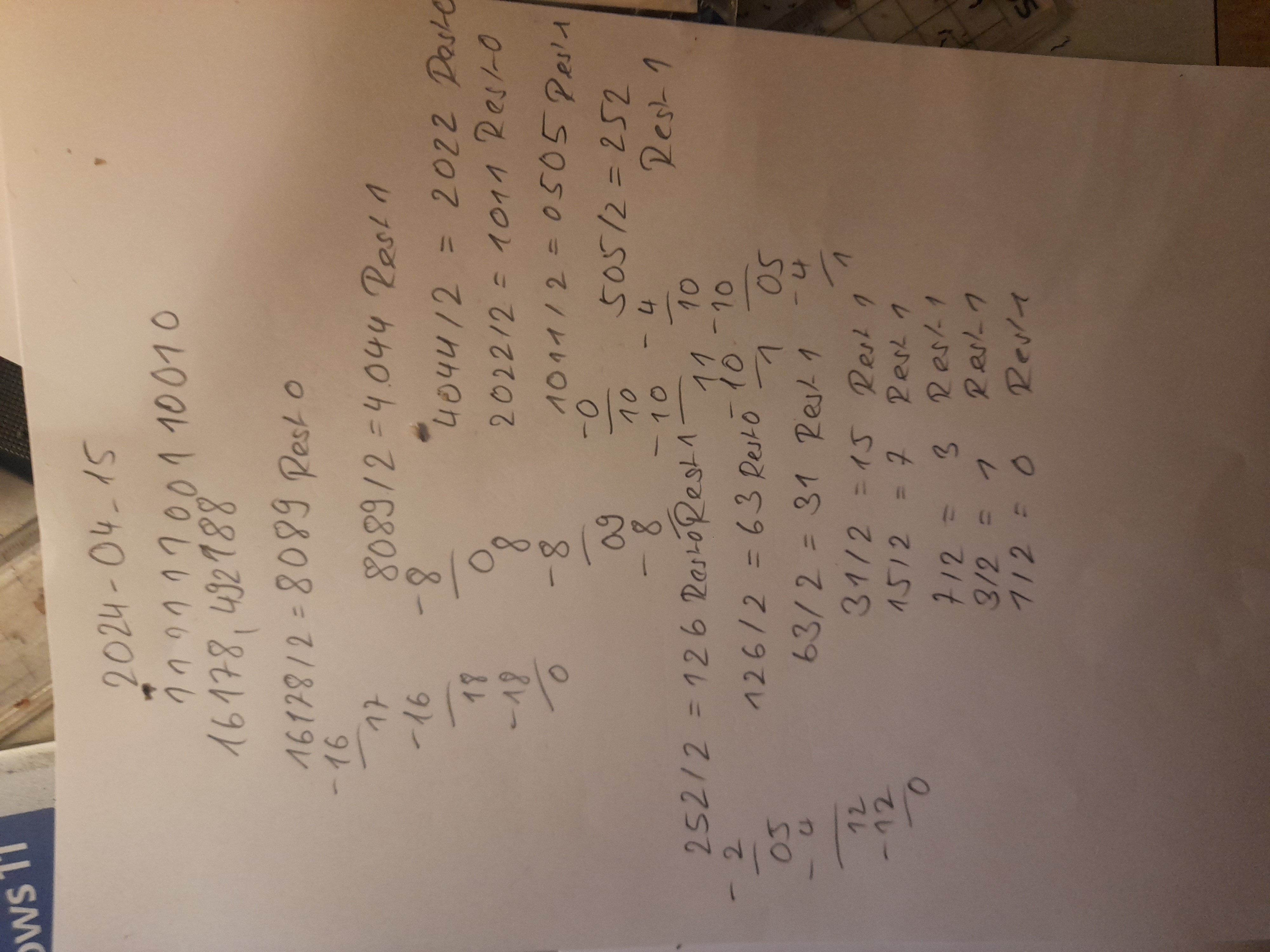

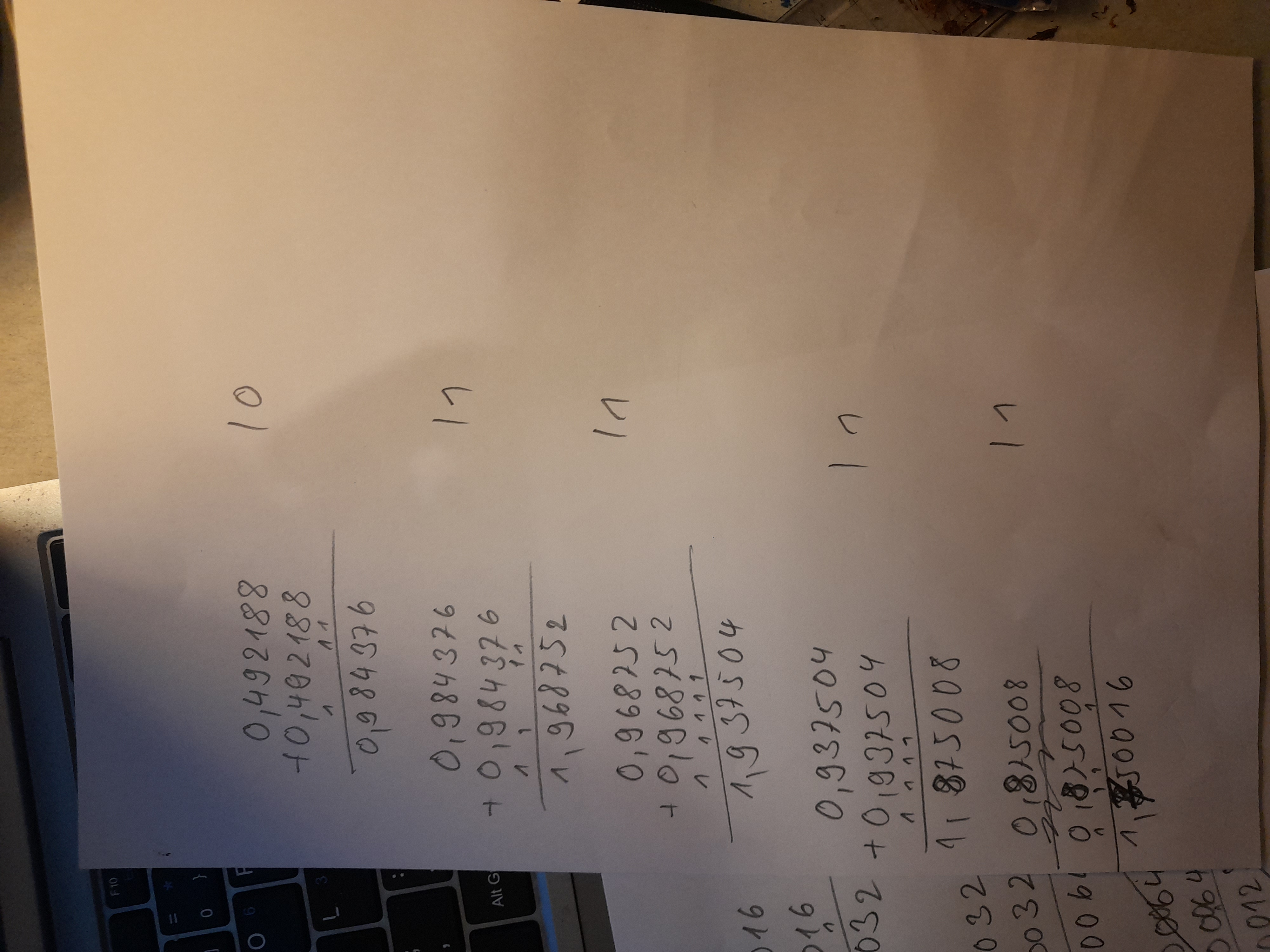
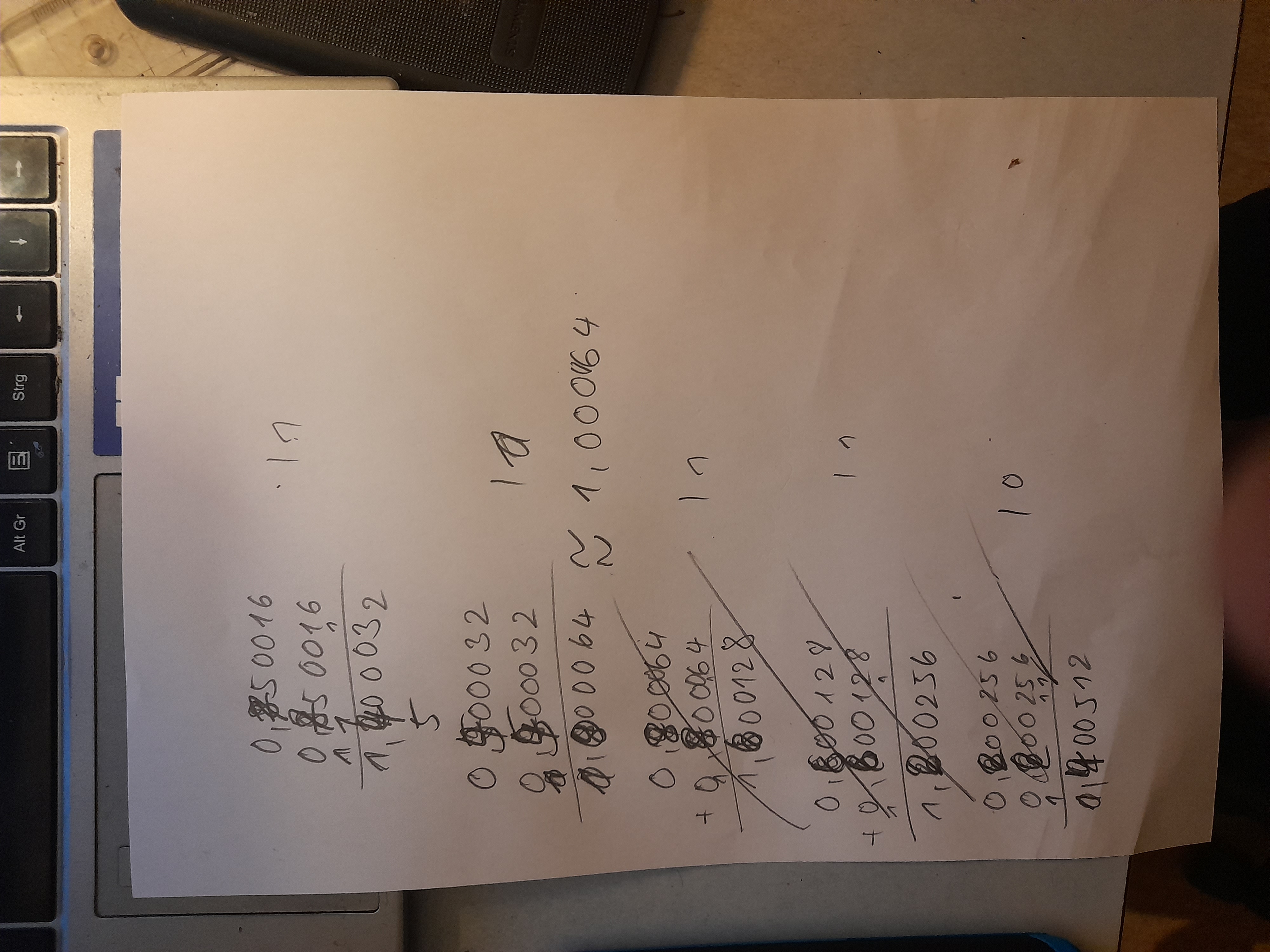
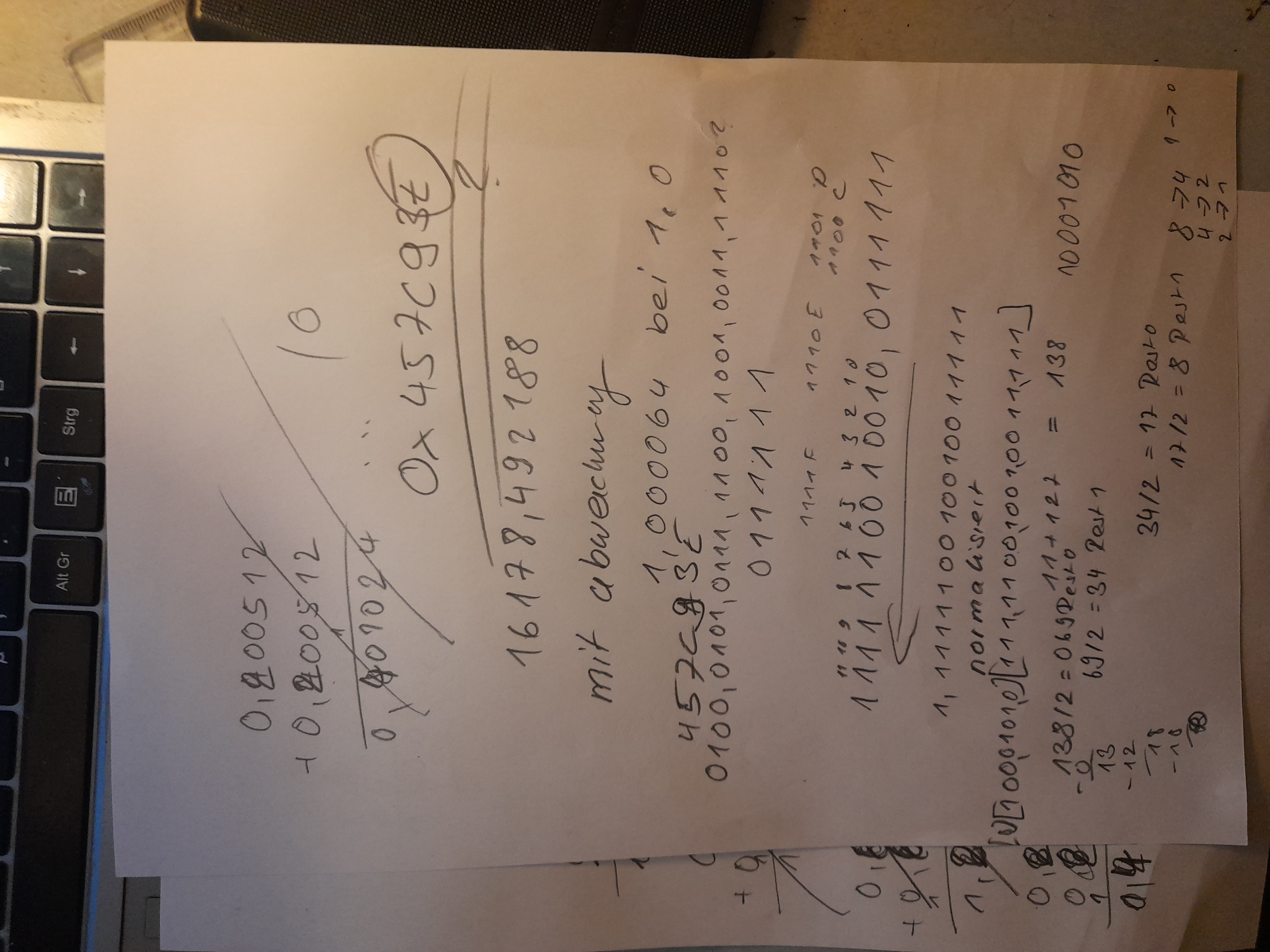
global _start
section .data
ToSrtArray: db "hajdasdahdsjadsj", 0x00
ToSrtArrayLen: equ \$-ToSrtArray
section .text
_start:
mov esi, ToSrtArray
loop1:
mov ah, [esi]
cmp ah, 0x00
je loop1end
mov edi, esi
loop2:
inc edi
mov al, [edi]
cmp al, 0x00
je loop2end
mov ah, [esi]
mov al, [edi]
cmp ah, al
jle goon
mov ah, [esi]
mov al, [edi]
mov [esi], al
mov [edi], ah
goon:
jmp loop2
loop2end:
inc esi
jmp loop1
loop1end:
mov edx, ToSrtArrayLen
mov ecx, ToSrtArray
mov ebx, 1
mov eax, 4
int 0x80
mov ebx, 0
mov eax, 1
int 0x80
assemble: nasm -f elf64 -g asm20240415.asm link: ld -m elf_x86_64 -g asm20240415.o -o asm20240415 run: ./asm20240415
david@laptop-peaq:~\$ make nasm -f elf64 -g asm20240415.asm david@laptop-peaq:~\$ make link ld -m elf_x86_64 -g asm20240415.o -o asm20240415 david@laptop-peaq:~\$ make run ./asm20240415 aaaaddddhhjjjsssdavid@laptop-peaq:~\$
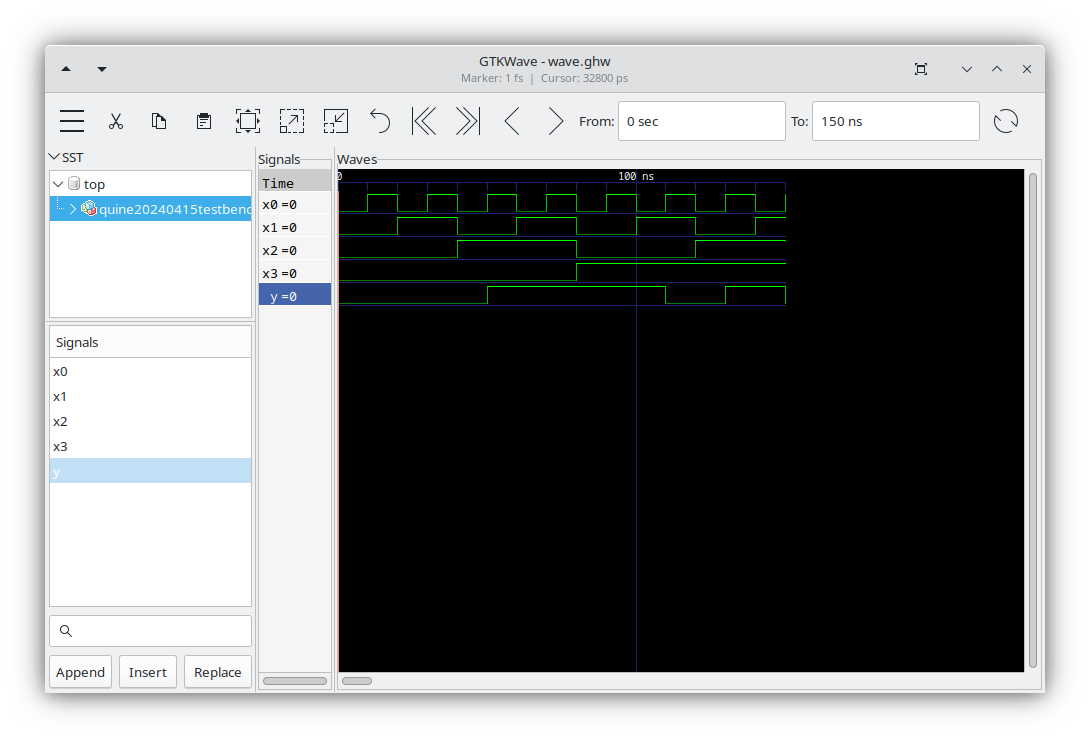
0 0 0 0 0 0
1 0 0 0 1 0
2 0 0 1 0 0
3 0 0 1 1 0
4 0 1 0 0 0
5 0 1 0 1 1
6 0 1 1 0 1
7 0 1 1 1 1
8 1 0 0 0 1
9 1 0 0 1 1
10 1 0 1 0 1
11 1 0 1 1 0
12 1 1 0 0 0
13 1 1 0 1 1
14 1 1 1 0 1
15 1 1 1 1 0
5 0 1 0 1 1
6 0 1 1 0 1
7 0 1 1 1 1
8 1 0 0 0 1
9 1 0 0 1 1
10 1 0 1 0 1
13 1 1 0 1 1
14 1 1 1 0 1
Gruppe 1:
8 1 0 0 0 1
Gruppe 2:
5 0 1 0 1 1
6 0 1 1 0 1
9 1 0 0 1 1
10 1 0 1 0 1
Gruppe 3:
7 0 1 1 1 1
13 1 1 0 1 1
14 1 1 1 0 1
8:9 1 0 0 -
8:10 1 0 - 0
5:7 0 1 - 1
5:13 - 1 0 1
6:7 0 1 1 -
6:14 - 1 1 0
9:13 1 - 0 1
10_14 1 - 1 0
8:9 1 0 0 -
6:7 0 1 1 -
8:10 1 0 - 0
5:7 0 1 - 1
9:13 1 - 0 1
10_14 1 - 1 0
5:13 - 1 0 1
6:14 - 1 1 0
Gruppe 1:
8:9 1 0 0 -
Gruppe 2:
6:7 0 1 1 -
Gruppe 1:
8:10 1 0 - 0
Gruppe 2:
5:7 0 1 - 1
Gruppe 2:
9:13 1 - 0 1
10_14 1 - 1 0
Gruppe 2:
5:13 - 1 0 1
6:14 - 1 1 0
8:9 1 0 0 -
6:7 0 1 1 -
8:10 1 0 - 0
5:7 0 1 - 1
9:13 1 - 0 1
10_14 1 - 1 0
5:13 - 1 0 1
6:14 - 1 1 0
5 6 7 8 9 10 13 14
8:9 * *
6:7 * *
8:10 * *
5:7 * *
9:13 * *
10_14 * *
5:13 * *
6:14 * *
5 6 7 8 9 10 13 14
8:9 * * K
6:7 * * K
8:10 * * K
5:7 * * K
9:13 * * K
10_14 * * K
5:13 * * K
6:14 * * K
5 6 7 8 9 10 13 14
6:7 * *
8:10 * *
5:7 * *
9:13 * *
10_14 * *
6:7 0 1 1 -
8:10 1 0 - 0
5:7 0 1 - 1
9:13 1 - 0 1
10_14 1 - 1 0
y <= (not x3 and x2 and x1) or
(x3 and not x2 and not x0) or
(not x3 and x2 and x0) or
(x3 and not x1 and x0) or
(x3 and x1 and not x0);
library ieee;
use ieee.std_logic_1164.all;
entity quine20240415 is
port (
x3, x2, x1, x0: in std_logic;
y: out std_logic
);
end;
architecture behaviour of quine20240415 is
begin
y <= (not x3 and x2 and x1) or
(x3 and not x2 and not x0) or
(not x3 and x2 and x0) or
(x3 and not x1 and x0) or
(x3 and x1 and not x0);
end;
library ieee;
use ieee.std_logic_1164.all;
entity quine20240415testbench is
port (
y: out std_logic
);
end;
architecture behaviour of quine20240415testbench is
component quine20240415
port (
x3, x2, x1, x0: in std_logic;
y: out std_logic
);
end component;
signal x3, x2, x1, x0: std_logic;
begin
q: quine20240415 PORT MAP (x3=>x3, x2=>x2, x1=>x1, x0=>x0, y=>y);
library ieee;
use ieee.std_logic_1164.all;
entity quine20240415 is
port (
x3, x2, x1, x0: in std_logic;
y: out std_logic
);
end;
architecture behaviour of quine20240415 is
begin
y <= (not x3 and x2 and x1) or
(x3 and not x2 and not x0) or
(not x3 and x2 and x0) or
(x3 and not x1 and x0) or
(x3 and x1 and not x0);
end;
library ieee;
use ieee.std_logic_1164.all;
entity quine20240415testbench is
port (
y: out std_logic
);
end;
architecture behaviour of quine20240415testbench is
component quine20240415
port (
x3, x2, x1, x0: in std_logic;
y: out std_logic
);
end component;
signal x3, x2, x1, x0: std_logic;
begin
q: quine20240415 PORT MAP (x3=>x3, x2=>x2, x1=>x1, x0=>x0, y=>y);
x0 <= '0' after 0 ns, '1' after 10 ns, '0' after 20 ns, '1' after 30 ns, '0' after 40 ns, '1' after 50 ns, '0' after 60 ns, '1' after 70 ns, '0' after 80 ns, '1' after 90 ns, '0' after 100 ns, '1' after 110 ns, '0' after 120 ns, '1' after 130 ns, '0' after 140 ns, '1' after 150 ns;
x1 <= '0' after 0 ns, '0' after 10 ns, '1' after 20 ns, '1' after 30 ns, '0' after 40 ns, '0' after 50 ns, '1' after 60 ns, '1' after 70 ns, '0' after 80 ns, '0' after 90 ns, '1' after 100 ns, '1' after 110 ns, '0' after 120 ns, '0' after 130 ns, '1' after 140 ns, '1' after 150 ns;
x2 <= '0' after 0 ns, '0' after 10 ns, '0' after 20 ns, '0' after 30 ns, '1' after 40 ns, '1' after 50 ns, '1' after 60 ns, '1' after 70 ns, '0' after 80 ns, '0' after 90 ns, '0' after 100 ns, '0' after 110 ns, '1' after 120 ns, '1' after 130 ns, '1' after 140 ns, '1' after 150 ns;
x3 <= '0' after 0 ns, '0' after 10 ns, '0' after 20 ns, '0' after 30 ns, '0' after 40 ns, '0' after 50 ns, '0' after 60 ns, '0' after 70 ns, '1' after 80 ns, '1' after 90 ns, '1' after 100 ns, '1' after 110 ns, '1' after 120 ns, '1' after 130 ns, '1' after 140 ns, '1' after 150 ns;
end;
Nebenbei
Das Minix wird ihnen stark helfen Linux zu verstehen - ich sage mal so - Minix verwendet bei Alloc eine simple Freispeicherliste - die MMU ist mit CR3 Controllerregistern ... nicht schwer zu verwenden Gut, ist sie lernen, das Disketten Laufwerk an zu steuern. Aber noch viel mehr. Sie lernen den IBM PC kennen Da geht es um Enhanced Graphics Adapter Color Graphics Adapter (40x25, 80x25) Professional Graphics Controller Monochrome Das weiss ich "ubrigens nicht wegen Minix, sondern wegen meinem IBM PC 5162. Sie m"ussten das f"ur ihre graphikkarte kennen. Die hat ausser einen RAMDAC und einem Adapter - wie bei Enhanced Graphics Adapter, ausserdem noch einen Prozessor - die GPU Und das ist ein Thema, das betrifft Linux. Ich empfehle Assembler lernen und VHDL besonders VHDL - der Witz ist halt dass sie mit CUDA, da werde ich demn"achst einsteigen, die GPU mit Assembler mehr oder weniger programmieren k"onnen Und Linux ist mehr als einafch nur die MMU ansteuern. Es geht um Wayland, und OpenGL und so weiter Inspirieren lasse ich mich immer wieder von linuxnews.de Ich empfehle die Seite. Ich habe dort auch schon Anregungen bekommen, was mein system betrifft Aber ich empfehle das alles nicht so b"ose zu nehmen. Weil - der Witz ist halt - ich lerne das Minix auswendig - das Linux - na ja, ich habe viele B"ucher mit Kernel 2.2 und 2.4. Das lesen sie dann durch. Wenn sie Minix 1.0 auswendig kennen, von mir aus ohne Filesystem - aber, wenn sie das auswendig kennen. Dann wenden sie sich Linux zu. Und das muss nicht zu 100% sitzen Ansonsten empfehle ich die software nicht immer nur von ihren Innenleben zu studieren Ich empfehle CUDA und Assembler unanabh"angig von Wayland aus zu probieren. Was sich empfiehlt die Software von oben her zu kennen Die VHDL "Ubungen sind unbedingt notwendig Und ich verspreche, der MIPS32, wird kommen. Ich bin halt gerade sehr hart in der Sache drin ein einfacher MIPS32, in VHDL ist relativ einfach. Wir machen das! Versprochen Aber so weiter machen, dann geht am Ende alles ganz rasant.
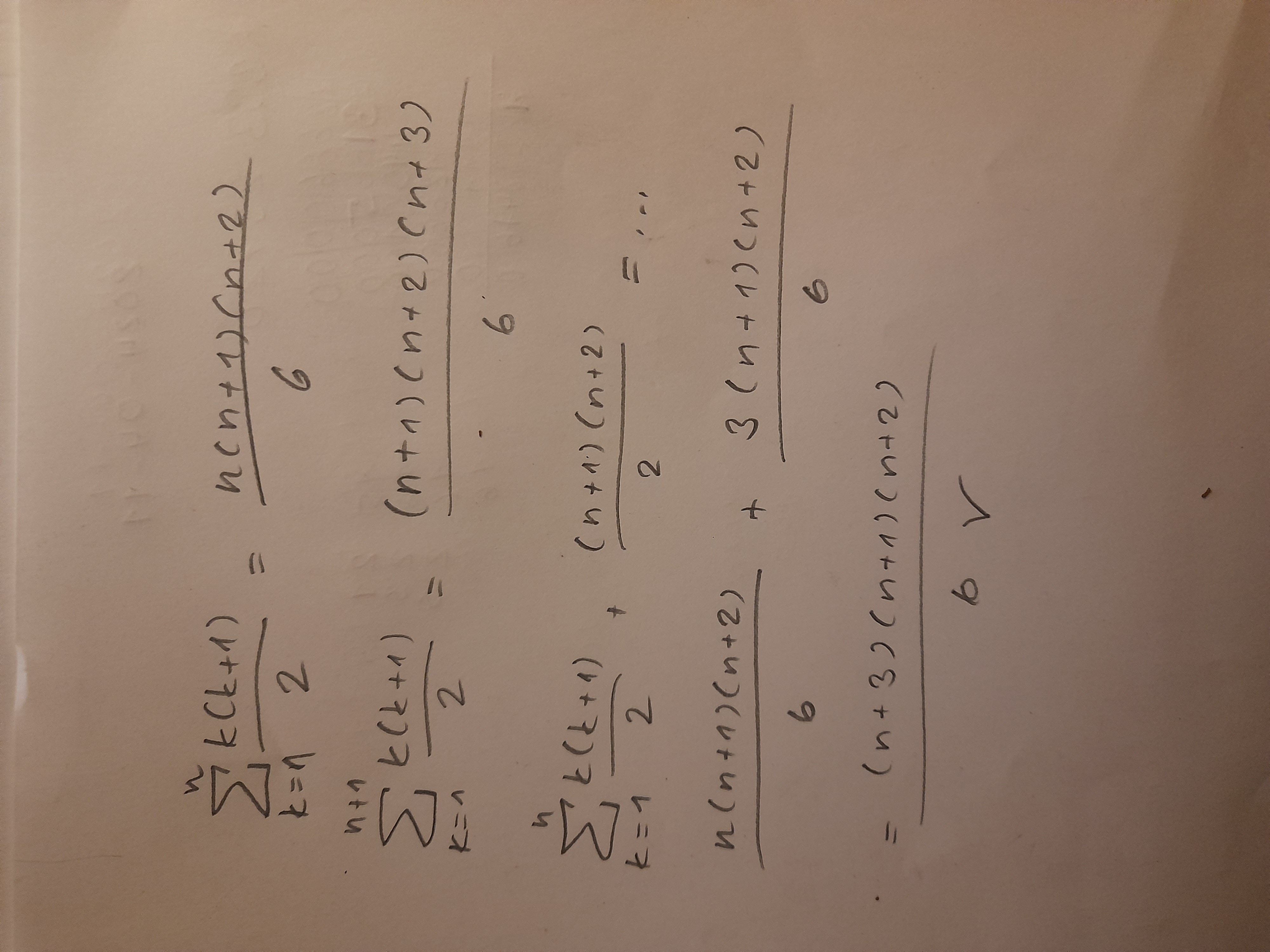
Zustand Folge-Zustand fuer Ausgang x=0 x=1 1 4 3 0 2 2 6 0 3 1 4 0 4 3 1 0 5 4 6 0 6 1 7 0 7 2 7 0 8 4 3 1 1 4 3 0 2 2 6 0 3 1 4 0 4 3 1 0 5 4 6 0 6 1 7 0 7 2 7 0 (1,2) (4,2) (3,6) (1,3) (4,1) (3,4) (1,4) (4,3) (3,1) (1,5) (4,4) (3,6) (1,6) (4,1) (3,7) (1,7) (4,2) (3,7) (2,3) (2,1) (6,4) (2,4) (2,3) (6,1) (2,5) (2,4) (6,6) (2,6) (2,1) (6,7) (2,7) (2,2) (6,7) (3,4) (1,3) (4,1) (3,5) (1,4) (4,6) (3,6) (1,1) (4,7) (3,7) (1,2) (4,7) (3,5) (1,4) (4,6) (3,6) (1,1) (4,7) (4,5) (3,4) (1,6) (4,6) (3,1) (1,7) (4,7) (3,2) (1,7) (5,6) (4,1) (6,7) (5,7) (4,2) (6,7) (6,7) (1,2) (7,7) 8 4 3 1 (1,2) (2,4) (3,6) (1,3) (1,4) (3,4) (1,4) (3,4) (1,3) (1,5) (3,6) (1,6) (1,4) (3,7) (1,7) (2,4) (3,7) (2,3) (1,2) (4,6) (2,4) (2,3) (1,6) (2,5) (2,4) (2,6) (1,2) (6,7) (2,7) (6,7) (3,4) (1,3) (1,4) (3,5) (1,4) (4,6) (3,6) (4,7) (3,7) (1,2) (4,7) (3,5) (1,4) (4,6) (3,6) (4,7) (4,5) (3,4) (1,6) (4,6) (1,3) (1,7) (4,7) (2,3) (1,7) (5,6) (1,4) (6,7) (5,7) (2,4) (6,7) (6,7) (1,2) (1,2) (2,4) (3,6) (1,3) (1,4) (3,4) (1,4) (3,4) (1,3) (1,5) (3,6) (1,6) (1,4) (3,7) (1,7) (2,4) (3,7) (2,3) (1,2) (4,6) (2,4) (2,3) (1,6) (2,5) (2,4) (2,6) (1,2) (6,7) (2,7) (6,7) (3,4) (1,3) (1,4) (3,5) (1,4) (4,6) (3,6) (4,7) (3,7) (1,2) (4,7) (3,5) (1,4) (4,6) (3,6) (4,7) (4,5) (3,4) (1,6) (4,6) (1,3) (1,7) (4,7) (2,3) (1,7) (5,6) (1,4) (6,7) (5,7) (2,4) (6,7) (6,7) (1,2) Gut hier m"ussen keine gestrichen werden, alle Zust"ande haben die Ausgabe 0 und enden in dem selben Szenario, d.h, wir brauchen nur: 8 3 3 1 3 3 3 0
